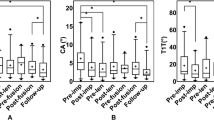Abstract
Purpose
Patients with adolescent idiopathic scoliosis (AIS) often present with a disfiguring shoulder imbalance. Shoulder balance (Sh.B) is of significant importance to the patient’s self-perception. Previous studies have correlated Sh.B with respect to only the clinical posterior view correlated with radiographs. It is important, however, to address Sh.B with respect to anterior view of the patients’ shoulders as if patients were viewing in a mirror. In this study, we evaluated the anterior Sh.B and correlated it with posterior Sh.B clinically and radiographically in Lenke type 1 and 2 curves.
Method
An online scoliosis database was queried to identify 74 AIS patients with Lenke 1 (n = 55, age 15.28 ± 3.35) and 2 (n = 19, age 15.66 ± 3.72) curves with a complete set of PA radiographs and anterior and posterior photos. Radiographic measures for Sh.B included Cobb angles, T1 tilt, first rib angle, and clavicle-rib intersection angle. Clinical measures for Sh.B included inner shoulder angle, outer shoulder angle, and axillary fold angle. Regression analysis with Pearson’s correlation and ANOVA for statistical significance was used for analysis.
Results
For Lenke 1 curves, there was moderate statistically significant correlation between anterior and posterior clinical Sh.B (R = 0.35–0.41). There was only weak to moderate correlation between radiographic and clinical measures. For Lenke 2 curves, there was a weak to moderate correlation between anterior and posterior clinical Sh.B (R = 0.25–0.45), though not statistically significant. There was no statistically significant correlation between any radiographic measures and posterior Sh.B. There was, however, moderate and significant correlation between radiographic measures and anterior Sh.B.
Conclusion
There is no strong correlation between anterior and posterior clinical Sh.B, and surgeons should evaluate both sides in planning deformity correction, especially in Lenke 2 curves. None of the radiographic measures showed strong correlation (R > 0.8) with anterior or posterior clinical Sh.B. A stronger correlation existed between radiographic measures and anterior Sh.B measurements compared with posterior clinical Sh.B measurements in Lenke 2 curves further necessitating anterior evaluation in this group.


Similar content being viewed by others
References
Orvomaa E (1998) Psychological evaluations of patients operated for idiopathic scoliosis by the Harrington method. Int J Rehabil Res 21(2):169–178
Danielsson AJ, Wiklund I, Pehrsson K et al (2001) Health-related quality of life in patients with adolescent idiopathic scoliosis: a matched follow-up at least 20 years after treatment with brace or surgery. Eur Spine J 10(4):278–288
Payne WK III, Ogilvie JW, Resnick MD et al (1997) Does scoliosis have a psychological impact and does gender make a difference? Spine 22(12):1380–1384
Asher MA, Burton DC (2006) Adolescent idiopathic scoliosis: natural history and long term treatment effects. Scoliosis 1(1):2
Qiu XS, Ma WW, Li WG, Wang B et al (2009) Discrepancy between radiographic shoulder balance and cosmetic shoulder balance in adolescent idiopathic scoliosis patients with double thoracic curve. Eur Spine 18(1):45–51
Akel I, Pekmezci M, Hayran M, Genc Y et al (2008) Evaluation of shoulder balance in the normal adolescent population and its correlation with radiological parameters. Eur Spine J 3:348–354
Margulies JY, Floman Y, Robin GC et al (1998) An algorithm for selection of instrumentation levels in scoliosis. Eur Spine J 7(2):88–94
King HA (1988) Selection of fusion levels for posterior instrumentation and fusion in idiopathic scoliosis. Orthop Clin North Am 19(2):247–255
Arlet V, Reddi V (2007) Adolescent idiopathic scoliosis: Lenke type I–VI case studies. Neurosurg Clin N Am 18(2):e1–e24
Bago J, Carrera L, March B et al (1996) Four radiological measures to estimate shoulder balance in scoliosis. J Pediatr Orthop B 5(1):31–34
Yang S, Jones-Quaidoo SM, Eager M, Griffin JW et al (2011) Right adolescent idiopathic thoracic curve (Lenke 1 A and B): does cost of instrumentation and implant density improve radiographic and cosmetic parameters? Eur Spine J 20(7):1039–1047
Ilharreborde B, Even J, Lefevre Y et al (2008) How to determine the upper level of instrumentation in Lenke types 1 and 2 adolescent idiopathic scoliosis: a prospective study of 132 patients. J Pediatr Orthop 28(7):733–739
Acknowledgments
This study was funded in part by Synthes through a research salary grant.
Conflict of interest
None.
Author information
Authors and Affiliations
Corresponding author
Rights and permissions
About this article
Cite this article
Yang, S., Feuchtbaum, E., Werner, B.C. et al. Does anterior shoulder balance in adolescent idiopathic scoliosis correlate with posterior shoulder balance clinically and radiographically?. Eur Spine J 21, 1978–1983 (2012). https://doi.org/10.1007/s00586-012-2434-5
Received:
Revised:
Accepted:
Published:
Issue Date:
DOI: https://doi.org/10.1007/s00586-012-2434-5




